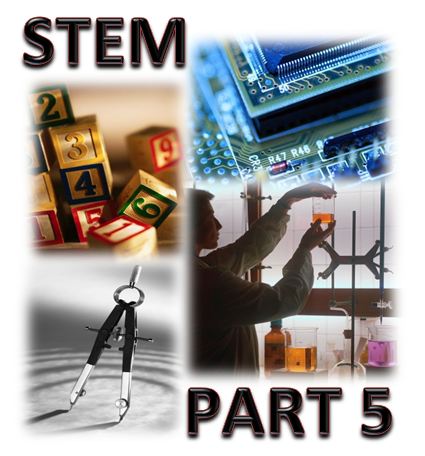STEM Resource Series: Over 70 Stemtastic Sites, Pt. 5

Sunrise – – Virtual learning can be considered 3D learning without boundaries. Explore this amazing technology that allows you to step into an interactive environment full of information. It might be visiting New York, exploring the human cell, flying through the Solar System, or traveling back in time to Ancient Egypt. Experiencing something in real-time 3D allows any subject to become more understandable. Complex ideas soon become accessible and understandable.
The Connectory – This is a new STEM opportunity that will open in April 2015, so visit the sight and sign up for their newsletter now. The Connectory will be a searchable database for all people interested in STEM.. It is designed to increase access to high-quality science, technology, engineering and math (STEM) education beyond the classroom for youth and families across the nation and in their local communities. This Directory will house thousands of STEM opportunities, submitted by science centers, museums, schools and other youth-serving organizations.
Understanding Science… How Science Really Works – Discover this assembly of resources to help educators increase student understanding of nature and process of science. There is a collection of wonderful lesson plans, teaching tips, and pedagogical strategies You can also visit a Teacher’s Lounge or explore the all-level resources. It is fun to discover how science really works.
Rubistar – This is a wonderful free tool, supported by a grant funded by the U.S. Department of Education. Its goal is to help educators with the creation of assessment rubrics for a wide variety of student activities. There are numerous STEM possibilities that will guide student learning and assessment. You may even wish to build some of your own 21st Century Skill rubrics that are so important to the verbs yo find in your STEM Standards.
The Conrad Foundation –This is a program for high school students and their coaches (teachers, parents) to Get Their Genius On. Students use science, technology, and engineering and math skills as teams develop innovative products to help solve global and local problems while supporting global sustainability. The Conrad Challenge matches participants with world-renowned scientists, engineers and entrepreneurs as mentors.
FUSE- Discover this new kind of interest-driven learning experience being developed by researchers at Northwestern University. Their goal is to engage pre-teens and teens in science, technology, engineering, arts/design, and mathematics (STEAM) topics while fostering the development of important 21st century skills. Along with the 4 C’s, this means adaptive problem solving, creativity, self-directed learning, persistence, and grit
Project Breaker – Discover a mission to drive social innovation and alternative learning by mobilizing interdisciplinary teams of young creative collaborators to help solve the world’s most pressing problems. Project Breaker connects young people with global thought leaders and industry experts to answer challenges like literacy, urban agriculture, STEM, and other technology for civic engagement. Students engage in creative problem-solving design process and teach the entrepreneurial skills necessary to transform ideas into businesses.
Tools and ideas to transform education. Sign up below.
Real World Design Challenges – RWDC is an annual competition that provides high school students, grades 9-12, the opportunity to work on real world engineering challenges in a team environment. Student teams address a challenge that confronts our nation’s leading industries. Students utilize professional engineering software to develop their solutions and also generate presentations that convincingly demonstrate the value of their solutions.
One World Education – This organization provides middle and high school Common Core literacy programs and allows for the publishing of student essays on cultural, STEM, and global issues. This facilitation allows for non-fiction reading and writing, while promoting peer-to-peer learning, and building college and career writing skills.
STEM Education Data Trends – How well prepared are the students in your state in science and mathematics? Am I doing enough to help my students? What are the various career opportunities in science and engineering fields? How much do science and engineering workers really earn? This website from NSF allows anyone to explore the answers to these and other questions, by providing easy access to data on science, technology, engineering, and mathematics (STEM) education and related careers
Thank you for joining me and I hope you found this information something you can use in your school and useful to share with other educators. As always, I invite you to follow me on twitter (@mjgormans). Please give this post a retweet and pass it on to someone who will benefit. To ensure you do not miss a future valuable post or other resource covering PBL, Digital Curriculum, STEM, 21st century learning, and technology integration please sign up for 21centuryedtech by email or RSS. Have a great week… enjoy the Websites! – Mike (https://21centuryedtech.wordpress.com/
Coming Soon – The ABC’s of PBL and Deeper Learning… a series you will not want to miss. Sign Up Now!
cross-posted at 21centuryedtech.wordpress.com
Michael Gorman oversees one-to-one laptop programs and digital professional development for Southwest Allen County Schools near Fort Wayne, Indiana. He is a consultant for Discovery Education, ISTE, My Big Campus, and November Learning and is on the National Faculty for The Buck Institute for Education. His awards include district Teacher of the Year, Indiana STEM Educator of the Year and Microsoft’s 365 Global Education Hero. Read more at 21centuryedtech.wordpress.com.
